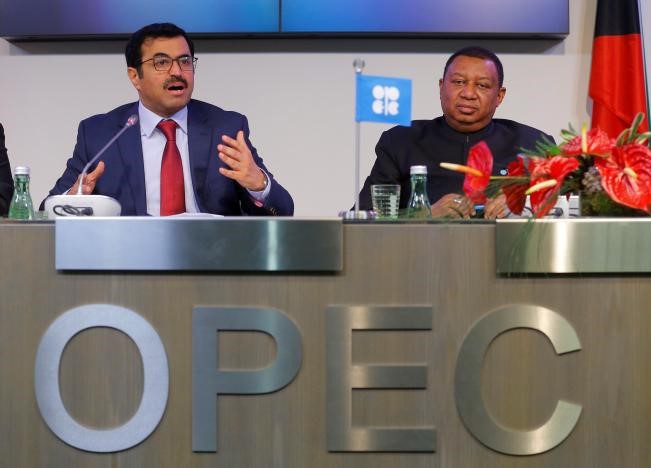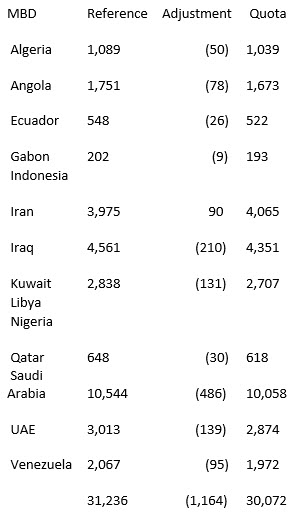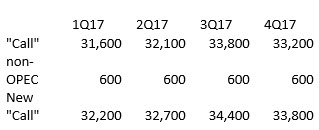

In line with the ‘Algiers Accord,' OPEC reported an agreement to limit its production to a new OPEC-14 production target of 32.5mb/d, “in order to accelerate the ongoing drawdown of the stock overhang and bring the oil market rebalancing forward. The Agreement will be effective from January 1, 2017.“ It will last six months but is “extendable” for another six months.
It did so by announcing “adjustments” to a “reference” case as follows. Three countries were not assigned cuts: Indonesia, which suspended its membership, and Libya and Nigeria, which are in the process of restoring their output from disruptions.

In addition OPEC claims that it has reached an agreement with non-OPEC producers, including Russia, to implement cuts of 600,000 b/d. There will be another meeting, December 9th, with non-OPEC producers.
Analysis
The unveiling of a detailed agreement is a surprise to me, especially in light of the positions taken by Iraq and Iran about developing their oil industries. I think it is naïve to believe they will all adhere to it.
Hypothetically, if it is fully implemented, they may be able to avoid yet another year of a large stock build. But their collective output is very likely to exceed the 32.5 million barrels per day, and the “call on OPEC oil” is still likely to be higher than their supply in the first half of 2017.
I constructed three scenarios below. The first is the “Quota/Oct” which means the new production level and October production for the three not included. That figure totals 33.0 million barrels per day.
The second scenario assumes Libya reaches 900,000 b/d, its goal by year-end, and Nigeria restores about 300,000 b/d, which is what it produced a year ago. That figure totals 33.6 million barrels per day.
The third scenario assumes Libya gets its production up to 1.5 million barrels per day, its goal for mid-2017. That figure totals 34.2 million barrels per day.
I next used OPEC’s own projections from its latest Monthly Oil Market Report to assess the supply-demand balance. I also adjusted it for the assumed non-OPEC 600,000 b/d cut.
This number is far from certain. Khalid Al Falih, Saudi Arabian minister of energy said:
"We're hoping for 600,000 (barrels per day to be cut) from non-OPEC (countries), so that is going to be a substantial volume that will bring health back into the market."
Russian Energy Minister Alexander Novak said in Moscow that it would cut by as much as 300,000 barrels a day “conditional on its technical abilities.” Russia had previously stated that its wells are old and they didn’t think they would come back if shut.
The “new call” calculated below shows that supply is likely to still exceed demand during the first half 2017, using the three supply scenarios above.

Conclusions
The supply cut announced is good news for the American shale oil industry. If crude futures prices rise into the $50s, approaching $60, they should hedge out for as many years as possible. This enables them to restore U.S. oil production by the one million barrels that was lost as a result of OPEC’s failed price war strategy. With additional incentives by the Trump administration, it may be able to reach American oil independence in 4-5 years.
Check back to see my next post!
Best,
Robert Boslego
INO.com Contributor - Energies
Disclosure: This contributor does not own any stocks mentioned in this article. This article is the opinion of the contributor themselves. The above is a matter of opinion provided for general information purposes only and is not intended as investment advice. This contributor is not receiving compensation (other than from INO.com) for their opinion.

American oil independence is a pipe dream, and if it ever does happen, it will be at considerable expense to the environment.
It is a billion dollar's question that how far such agreement will be followed? and how many members will retain their quota. We must also point-out that at currant juncture, markets are not driven simply on Demand - Supply equation, forward contracts playing much larger role thereof.
Apart then above, As far as Technical levels are concern, first $ 54 and there after $ 59, $ 61 required to be cross, and Final resistance is at around $ 65....which is very important to cross to find any turn around signal.
As per my study, currant correction may last up-to 2nd or 3rd weak of January, however, even in between too, oil will face quite resisting situation to cross even a initial bull range of between $ 54 to $ 59 levels too, and after crossing such range, further upper levels can be consider.
Excellent!